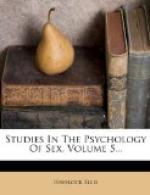The positive action of semen, or rather of the testicular products, has been much investigated during recent years, and appears on the whole to be demonstrated. The notable discovery by Brown-Sequard, a quarter of a century ago, that the ingestion of the testicular juices in states of debility and senility acted as a beneficial stimulant and tonic, opened the way to a new field of therapeutics. Many investigators in various countries have found that testicular extracts, and more especially the spermin as studied by Poehl,[140] and by him regarded as a positive katalysator or accelerator of metabolic processes, exert a real influence in giving tone to the heart and other muscles, and in improving the metabolism of the tissues even when all influences of mental suggestion have been excluded.[141]
As the ovaries are strictly analogous to the testes, it was surmised that ovarian extract might prove a drug equally valuable with testicular products. As a matter of fact, ovarian extract, in the form of ovarin, etc., would seem to have proved beneficial in various disorders, more especially in anaemia and in troubles due to the artificial menopause. In most conditions, however, in which it has been employed the results are doubtful or uncertain, and some authorities believe that the influence of suggestion plays a considerable part here.
There is, however, another use which is subserved by the testicular products, a use which may indeed be said to be implied in those uses to which reference has already been made, but is yet historically the latest to be realized and studied. It was not until 1869 that Brown-Sequard first suggested that an important secretion was elaborated by the ductless glands and received into the circulation, but that suggestion proved to be epoch-making. If these glandular secretions are so valuable when administered as drugs to other persons, must they not be of far greater value when naturally secreted and poured out into the circulation in the living body? It is now generally believed, on the basis of a large and various body of evidence, that this is undoubtedly so. In a very crude form, indeed, this belief is by no means modern. In opposition to the old writers who were inclined to regard the semen as an excretion which it was beneficial to expel, there were other ancient authorities who argued that it was beneficial to retain it as being a vital fluid which, if reabsorbed, served to invigorate the body. The great physiologist, Haller, in the middle of the eighteenth century, came very near to the modern doctrine when he stated in his Elements of Physiology that the sperm accumulated in the seminical vesicles is pumped back into the blood, and thus produces the beard and the hair together with the other surprising changes of puberty which are absent in the eunuch. The reabsorption of semen can scarcely be said to be a part of the modern physiological doctrine, but it is at least now generally held that the testes secrete substances which pass into the circulation and are of immense importance in the development of the organism.




